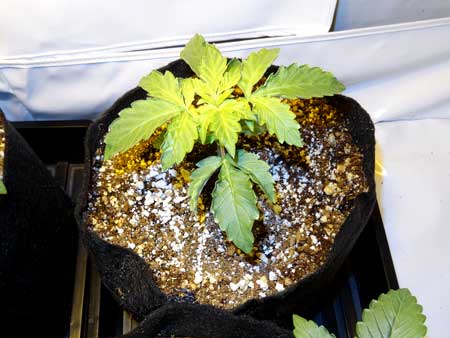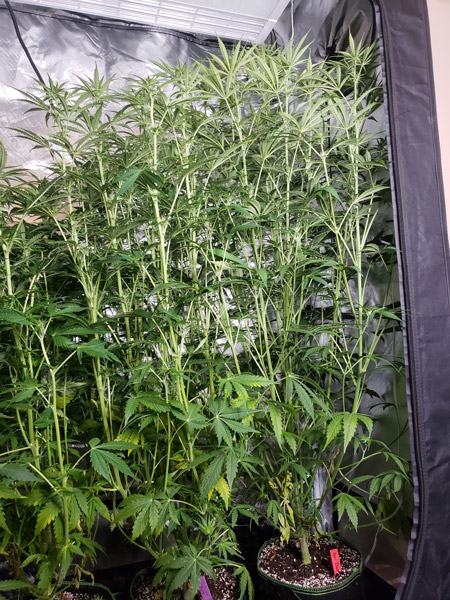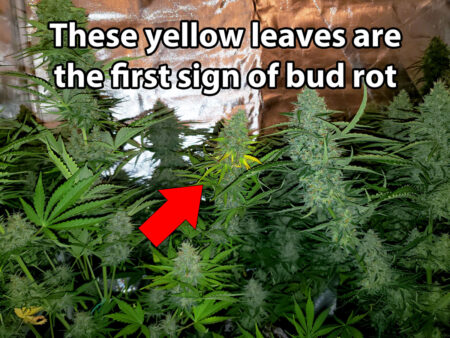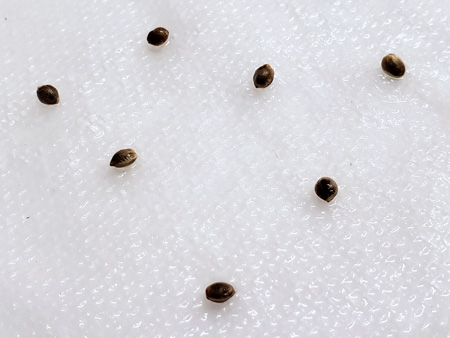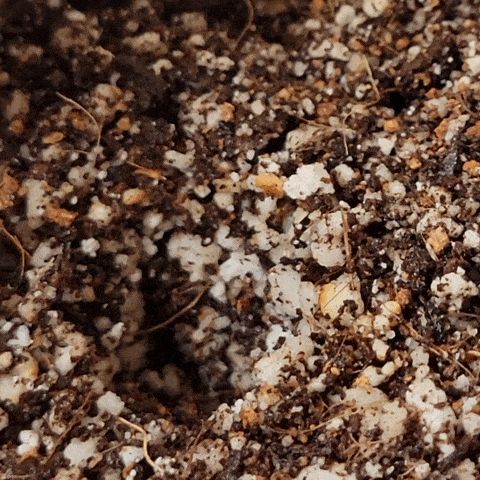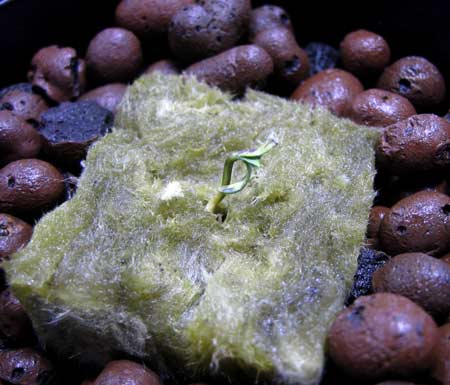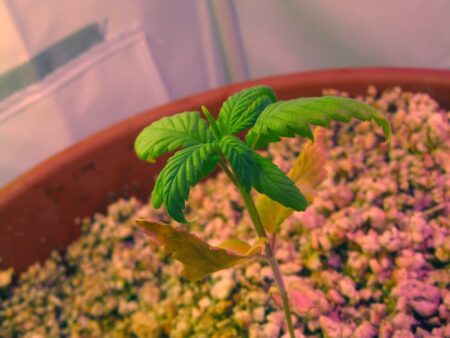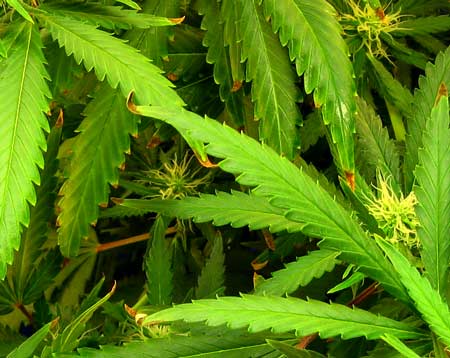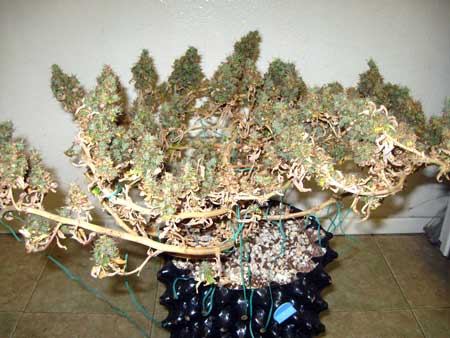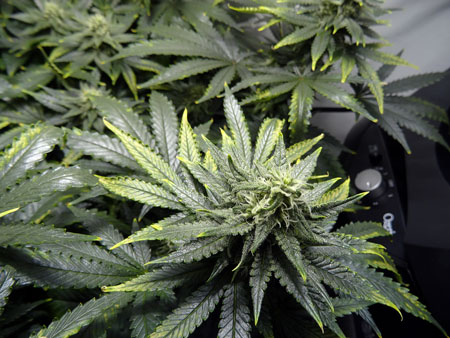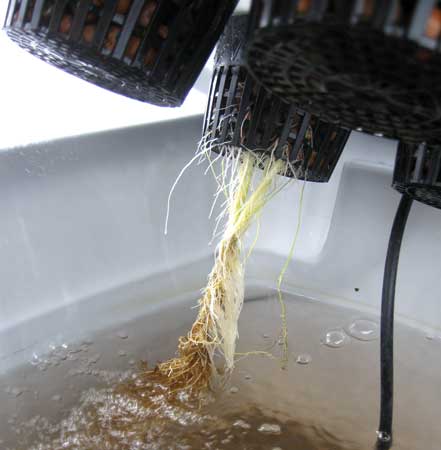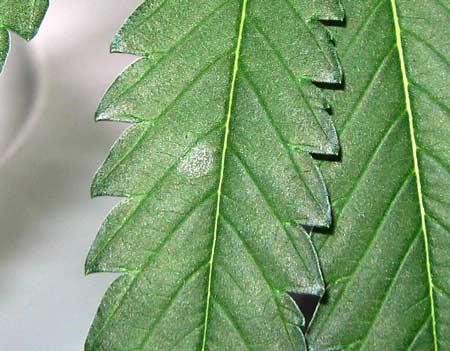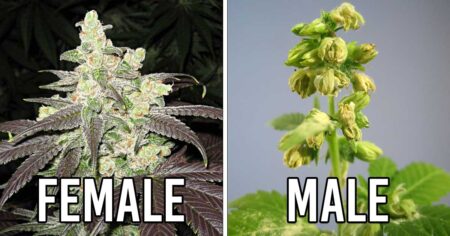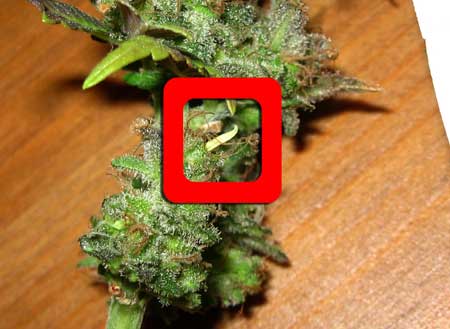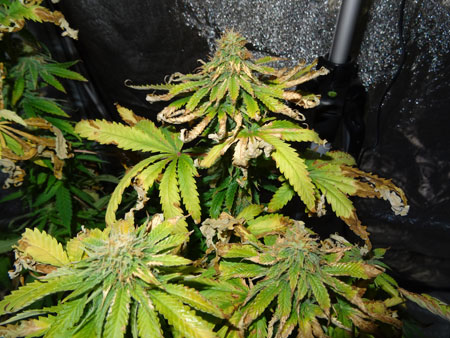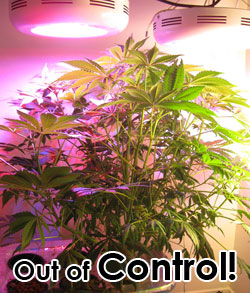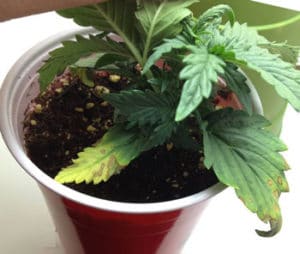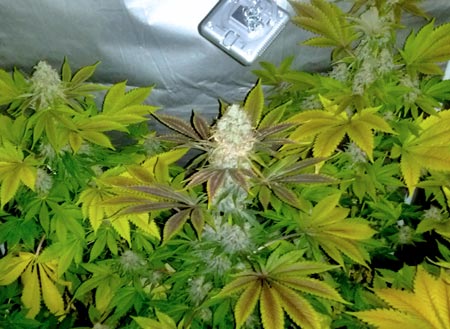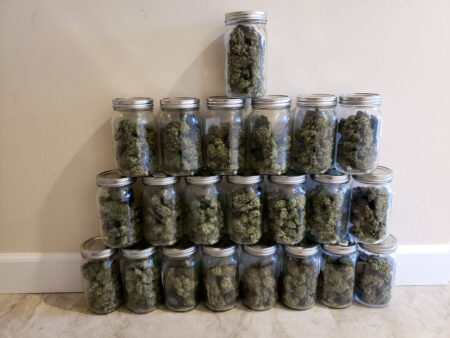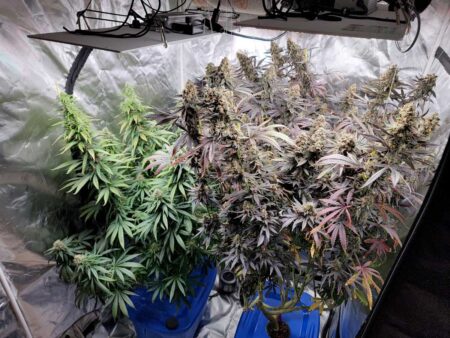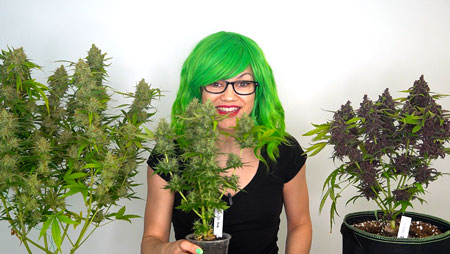by Nebula Haze
If you’ve ever felt frustrated about your cannabis plants, this article is for you. When it comes to growing weed, I’ve learned a lot of lessons the hard way. Take this droopy seedling with yellow leaves for example. I learned that some seedlings get nutrient deficiencies simply due to being overwatered. An easy mistake to fix, but only if you know what’s causing the problem.
This seedling got yellow leaves because I was watering it too often. A little less water, and it started growing normally.
After many similar incidents, it clicked for me what it really takes to become an excellent cannabis grower. Today, I want to share what may be the most important lesson I’ve learned in my time growing cannabis plants…
Don’t be ashamed when you run into problems!
Every cannabis grower makes mistakes, but only great growers learn from them.
~Nebula Haze
No matter your age, background, or level of intelligence (yes, even if you have a PhD in Horticulture), cannabis plants will surprise you. Even the most knowledgeable or naturally skilled growers will run into problems at some point. Whether it’s a minor bump in the road or a major setback, each challenge is the opportunity to learn something new.
This Sour Diesel cannabis plant grew out of control! A little pruning, bending, and tying down would have done wonders to prevent this.
Even advanced growers aren’t safe. For example, bud rot only tends to attack fat buds, so it affects the best cannabis growers more often than beginners.
What makes a great grower is the ability to bounce back from problems and learn from them. Every cannabis grower is going to run into problems, it’s how you deal with them that separates the average grower from the spectacular.
I’m no exception to this rule by any means; I’ve run into more than my fair share of problems over the years. If you want some more proof, just check out this gallery of cannabis growing problems that my partner Sirius and I have personally experienced. Yes, all the examples on this page are pictures of OUR past plant problems.
Seeds didn’t sprout.
Poor germination is one of the most common beginner cannabis growing problems.
In this picture, 3 days have passed since these seeds were put between wet paper towels. None sprouted. So frustrating!
Why does this happen? I’ve got germination down to a science now, but in the case above, I believe the issue was that these particular seeds were stored in terrible conditions. They were kept in the glove compartment of my Oldsmobile car for over a year, which was regularly parked outside in the hot San Diego sun. Seems obvious now that’s a bad place to keep seeds, but I didn’t realize at the time.
Let me share the most common reasons growers get poor cannabis germination rates:
- Too cold – Seeds need warm, wet conditions to germinate. Don’t let wet seeds be cold!
- Old seeds – Fresh seeds tend to germinate better and faster than older seeds. That being said, we’ve successfully germinated and harvested weed from 10+ year old seeds, so don’t give up on your older seeds.
- Poorly stored seeds – Bad storage conditions include high humidity, any contact with moisture, hot and cold temperature swings, etc. You get the best germination rates by storing cannabis seeds in a cool, dark, dry place.
- Planted too deep – Sometimes seedlings have trouble finding the surface if they sprout too deep in the soil. In general, plant seeds with just a bit of soil on top (pictured below).
- Moving the seeds – Germinating seeds like to be left alone. For example, if you’re germinating seeds with wet paper towels, avoid touching or moving the seeds after they are exposed to moisture. If possible, wait until seeds have germinated and you’re ready to put the seedlings in their next home before touching them.
- Sometimes it just happens – Unfortunately, no germination method is 100%. Plants are living things that have natural variation. Plus you often don’t know what happened to the seeds before they got to you.
Make sure to buy good cannabis seeds from a trustworthy source (lately I’ve been happy with Seed Supreme, and we also keep a list of recommended seed sources).
Learn how to prevent the most common germination problems.
If you’re struggling to germinate cannabis seeds, try the old-fashioned method. It’s simple and it works.
Seed sprouted but just didn’t grow.
Or perhaps it’s trailing behind the other cannabis seedlings. It happens…
This marijuana seedling never grew past this point. I didn’t know why at the time, but now I think it’s because the rockwool cube was too wet.
This cannabis seedling grew to this size and just stopped growing. Then the first leaves died! I remember feeling so frustrated, not realizing this was a case of overwatering. Its little roots were drowning.
Common culprits for slow-growing seedlings:
- Overwatering – Roots are too wet, too often. Seedlings don’t like “wet feet”. How often do I water cannabis seedlings?
- Cold – Seedlings need warmth for the fastest and best growth. They hate the cold!
- Poor lighting – Seedlings need direct light, but not too strong at first. Too strong or too weak light can cause cannabis seedlings to grow poorly. A good grow light kept twice the normal distance away, or at half power, is great for seedlings.
- Nutrients – Seedlings need access to nutrients immediately. In soil, that means they need their water to be the correct pH so they can absorb the nutrients in the soil. Incorrect pH is one of the most common reasons for nutrient deficiencies in any grow medium. In coco or hydro (which have no nutrients), you also need to add seedling-strength nutrients to the water.
- Old (or improperly stored) seeds – Even if older seeds germinate, sometimes the seedlings aren’t as vibrant and fast-growing as the seedlings from fresher seeds. If only the plants from a specific set of seeds are showing signs of problems, and all the rest are growing normally, that’s a sign it may have been the seeds.
- Genetics – Sometimes it’s just a matter of genetics or natural variation. If all your plants are happy except one, don’t be hard on yourself. You can’t expect every plant to be perfect.
Unhealthy leaves or nutrient deficiencies.
Discolored leaves or other leaf symptoms may be the next most common cannabis growing problem.
From one of my first grows, leaves are nutrient burnt – Learn about nutrient burn.
Common culprits for nutrient burn:
- “Hot” soil burns your seedlings – If you’re starting with a very nutrient-heavy or “hot” soil (for example Fox Farm Ocean Forest soil, or “Just Add Water” Super Soil), then cannabis seedlings may be overwhelmed and get nutrient burn right away. However, if you’re starting with a proven cannabis soil like the two listed here, they’ll grow out of this within a week or two.
- Too much nutrients in the water – Sometimes you see nutrient burn after a single example of giving water with too much nutrients. For example, you increase the nutrient dosage, or add a new supplement.
- Nutrient buildup in the grow medium – This happens if you regularly ad nutrients when water but never collect and remove runoff water that comes out the bottom of the plant pot. Collecting extra runoff helps collect any excess nutrients that the plant isn’t using. If you don’t give enough water to get runoff, it’s important to give just the right amount of nutrients. And if you do get runoff with nutrient water, it’s recommended to collect it instead of letting the plant absorb all the nutrients back up. Plus cannabis plants don’t like “wet feet”
Light stress is another common issue for cannabis growers. These buds were toasted by a too-close LED. It was just inches away from the tops of buds. When using an LED, make sure to know how far away it should be from your plants. It’s not just a matter of heat; most LED manufacturers suggest you keep LED grow lights a certain distance away from the tops of your plants to prevent bleaching and light burn. How far away should an LED grow light be from cannabis plants?
The buds were almost touching the LEDs, and this happened. At the time, I thought it was a nutrient deficiency…
Common culprits for symptoms of light stress:
- Old tech LEDs – Older models, “blurple” LEDs, etc. Some of these can be used perfectly and will still cause problems with your plants. Always buy LEDs that have been proven to work well for growing cannabis!
- Grow light too close – Even relatively small grow lights can cause light stress if you keep them too close.
- Too hot or cold – If it’s hot or cold in the grow space, then plants are more susceptible to light stress. Their leaves simply can’t work as hard when the temperature isn’t ideal.
- Nutrient problems – If the rest of the plant is green, and only the leaves under the grow light are stressed, you might conclude the problem has to be the light. And it’s true that when you see light stress, it will help the plant recover to move the grow light further away. But sometimes the real reason you’re seeing light stress is that your nutrients aren’t perfect. For example, the pH is too high or too low at the roots. When this happens, your leaves aren’t working at 100% and might get stressed out at light levels that normally the plant would be able to handle.
This cannabis plant had nutrient deficiencies everywhere due to incorrect pH at the roots – Learn how to fix your nutrient problem!
Plant Illnesses
Root Rot (most common grow problem in hydroponic setups) – Learn how to get rid of root rot.
Common culprits for root rot in a hydroponic setup:
- Warm water – The organisms that cause root rot tend to grow best when the water is warm. So if the room is hot, it’s likely the water is warm too. Especially if the plants are so small they offer no shade, which means the light is beaming down directly onto the lid of your water reservoir.
- Not enough bubbles in the water – Having lots of bubbles in the water reservoir “oxygenates” or adds a lot of oxygen to the water. This oxygen not only helps the plant grow much faster (more oxygen in the water = faster growth, up to a point) but also prevents a lot of bad organisms from growing.
- Light is getting to the roots – It should be completely dark in the water reservoir. If you have a thin lid or light leaks, then light from the grow light will reach the water. This causes not only root rot but also other unwanted organisms like algae. Make sure that no light gets into the reservoir. If your hydroponic lid is thin or light is coming in through the net pots, add a layer of tin foil over the top.
- No beneficial bacteria – One of the best ways to prevent root rot in a hydroponic setup is to add “bennies” or beneficial microorganisms (I like Hydroguard, but there are others) to the water that either support root health, or directly fight the common organisms that cause root rot.
- Roots get twisted or moved – This is common when roots are still small and fragile. If the roots get twisted, it can kill the roots below (like in the above picture) Once a plant is bigger with big roots, they can’t really be accidentally re-arranged. But it’s common for growers to unintentionally twist or move the roots when peaking in the reservoir or after changing the reservoir water. One way to prevent this is to not open the lid or change the water for the first few weeks of growth. Just let the roots grow how they want, and top off the water when it gets low. Don’t worry about changing all the water. Then after the plant is 4-5 weeks old, the roots will have hardened and they won’t get twisted. If you must move the roots of a young plant around, pay close attention when you put them back into the water to make sure all the roots are fully “fanned out” and separated from each other with no twisting.
Summary to prevent root rot: Keep roots cool and dark with lots of bubbles, add beneficial bacteria, and avoid disturbing young roots. Here’s the full tutorial on how to get rid of root rot.
White Powdery Mildew (white flour-like dust appears on leaves in spots) – Learn how to get rid of it.
WPM is a type of mold. It is especially unwanted during the flowering stage, because it can get on your buds!
Common culprits for White Powdery Mildew
- Hot temperature – Most mold, including white powdery mildew, tends to grow best when the air is warm or hot.
- High humidity – Like all molds, WPM needs moisture to grow and thrives on leaves that are in pockets of stagnant, humid air.
- No fresh air – WPM is often found where there is no good source of fresh air, for example in a closet or with a bunch of plants stuffed together in a small space.
- No breeze – White powdery mold is much more common when the air in the grow space is still, without a fan blowing air around. Add a breeze in the grow space, and mold doesn’t have a good place to grow.
Ultimately, controlling the temperature/humidity and having some fans is the best way to prevent white powdery mildew.
Plant Sex Problems
Male Plants – Only female cannabis plants make buds, but unless you start with feminized cannabis seeds, about half of all your plants will be male. Male plants only make pollen sacs, which can’t be smoked, and also releases pollen that causes seedy buds. To make sure all your plants produce non-seedy buds, it’s important to quickly spot and remove male plants from the grow area. Or just start with feminized seeds from a trustworthy breeder, which ensures all your cannabis plants will be female.
Only female plants grow buds. Immediately remove male cannabis plants, which grow pollen sacs where buds should be.
Learn about male vs female cannabis plants.
Hermies – Hermies are plants with both male and female traits, which can result in seedy buds (Learn more here)
Common culprits for hermies:
- Genetics – Some plants will herm no matter what you do. It’s important to start with good cannabis seeds from a trustworthy breeder!
- Heat or light stress – Plants experiencing a lot of heat, or receiving too-high levels of light, are much more likely to herm.
- Irregular light schedules – Cannabis plants don’t like if the light schedule is constantly changing. For example, if the timer is broken and lights aren’t coming on and off at the same time each day, it can cause issues. This is mainly for photoperiod strains of cannabis, as autoflowering strains don’t care much about light schedules.
- Light leaks – If light is somehow getting into the grow space during the plant’s dark period, it causes the same issues as irregular light schedules. Not only can this cause hermies but also accidental re-vegging, which will kill all the buds on your plant. Don’t ignore light leaks!
- Supplements – Certain flowering supplements can cause hermies for some strains. For example, certain “finishers” or “bud boosters” may trigger herming. This can be frustrating as these products may work perfectly well with some strains, while causing issues with others. But if you notice the herming happened right after introducing some new supplement, it may be the cause.
Learn how to identify and prevent hermie cannabis plants.
Plain and simple neglect
We all get busy sometimes, and maybe don’t pay as close attention to our cannabis plants as we know we should.
This plant that didn’t get the attention it needed and suffered from heat, light bleaching, pH problems and more. I knew how to prevent all these problems. I just got busy and sort of ignored them…
Here are several more super common yet unexpected or frustrating events for beginner cannabis growers:
Seeds don’t germinate.
Leaves get burnt, discolored or otherwise deformed.
Young plants die unexpectedly.
Space and growth problems…
Plants grow too big or too tall before you realize.
Plants grow slowly, sickly or stay small without an obvious reason.
Plants get dropped, accidentally broken or fall over (this happened to my first plant…)
Lower yields than expected.
Poor taste or smell in buds.
Undesired effects like racing thoughts (may be caused by harvesting too early).
Overwatering your cannabis seedlings is the most common beginner grower problem.
Cannabis plants are living beings with unique needs, just like us. Even if you’re an experienced grower and have had some smooth harvests under your belt, you may still run into mysterious symptoms or unexpected issues due to the differences between plants. What works for most cannabis plants might not work for all cannabis plants.
Every serious grower will encounter at least one of these problems at some point:
Mold, Mildew or Bugs – Especially bud rot, which tends to only infect big, fat buds (it’s so cruel!)
Unexpected pollination (seeded buds) from a hermie (male parts appearing on female plants) or an unrealized male plant
Grow area and environmental problems
Indoors: Electricity may go out, a piece of equipment fails.
Outdoors: Bad weather or temperature may slow down or cause damage to your plants.
You have to move (or drastically change) your growing operation.
Bud rot affects experienced growers more often than beginners, because it only tends to attack fat buds.
Some other big lessons I’ve learned…
1.) Take time to really look at your plants every day.
Doing a simple check on your plants will make a world of difference. Quite a bit can happen in a couple of days if you’re not paying attention.
2.) React quickly to problems.
Don’t wait until ‘this afternoon or tomorrow’ to address problems unless you actually have to. I know I’ve let laziness get the best of me a time or two and I’ve regretted it every time.
3.) Not every problem has an immediate obvious solution.
Sometimes there will be certain plants that have a problem that you just can’t figure out. Sometimes you’ll realize what the problem was later after you’ve gained more knowledge and experience, but some problems will always remain a mystery… and that’s okay!
4.) Other growers may know things you don’t.
Over the years, we’ve learned so many new things from fellow growers we meet or growers who write into the website. Often these discoveries solve old mysteries, or answer long-unanswered questions.
5.) Always keep learning!
Whether you just got started or have been growing for 30 years, there’s always more to learn about growing cannabis. If running GrowWeedEasy.com has taught us anything, it’s that there is a TON of new cannabis growing information, techniques, and discoveries coming out every day.
And of course, always start with good cannabis seeds!
Despite all the problems we’ve run into over the years….
We still harvest more weed than our household can use. And that’s after I turn a bunch of the weed into dry ice hash or cannabis capsules.
The truth is, once you get the hang of growing cannabis plants, each harvest can produce more weed than you know what to do with.
Looking for a strain suggestion?
Our last harvest included this Purple Ghost Candy plant on the right. It grows big plants covered in hard nuggets of ultra-potent buds. We highly recommended this strain if you want to grow a lot of weed with a hardy strain. It was surprisingly easy to grow (although it does get big, fast).
Our goal is to help growers get the yields and bud quality they want, regardless of what size plants you want to grow.
I hope this article can help inspire you to push on when you encounter problems, and most importantly, never give up on your ability to figure it out.
~Nebula Haze
Co-founder of GrowWeedEasy.com
Here are some additional resources to help you deal with problems when they show up:
Problem-Free Seed Germination & Cloning
Dealing with Sick Plants
Plant Doctor – Pictures & Interactive Tool to diagnose your sick plants
How to Control the Exact Size & Shape of Your Plants for bigger yields indoors
In case you missed it: The Basics of Growing
And here are a few other resources to help you beyond the defensive:
Learn how to make feminized seeds at home (just like the seed banks do) – No more male plants!
Looking for an interactive community to ask questions and share your progress? Check out the free Grow Weed Easy forum.
FOR SERIOUS GROWERS ONLY
If you want to learn the simple secrets to becoming a pro grower so you can start getting seriously killer harvests with less work…
Learn from the best!
Invest In The Most Advanced Grow Bible Available: Growing Elite Marijuana
Why spend days and weeks searching the online forums trying to find the answers to your simple questions? Why not instead get trained by one of the best growing experts on the planet?
You’ve told me you’re looking for a complete guide to growing marijuana that covers everything, from beginner to ultra-advanced, and this is it.
With over 700 pages of pictures, tutorials and advanced insider tips, this incredible resource will teach you the simple patterns followed by all cannabis plants, so you know exactly what you need to do to keep your plants happy.
Instead of worrying about your plants, you can worry about what to do with all the buds you harvest!
Get Instant Access to It All Right Here

